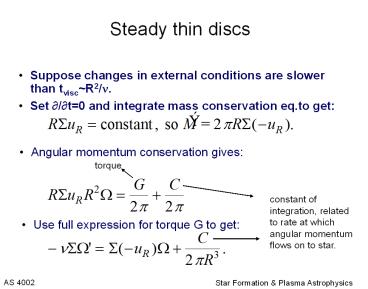Steady%20thin%20discs - PowerPoint PPT Presentation
Title:
Steady%20thin%20discs
Description:
Steady thin discs. Suppose changes in external conditions are slower than tvisc~R2 ... How long does it take for the disc to be depleted? ... – PowerPoint PPT presentation
Number of Views:31
Avg rating:3.0/5.0
Title: Steady%20thin%20discs
1
Steady thin discs
- Suppose changes in external conditions are slower
than tviscR2/?. - Set ?/?t0 and integrate mass conservation eq.to
get
- Angular momentum conservation gives
torque
constant of integration, related to rate at which
angular momentum flows on to star.
- Use full expression for torque G to get
2
Inner boundary condition
- If star rotates slower than breakup, at
equator - If material is braked from ?K to ? in a surface
boundary layer, width b ltlt R, then at point
where ?0
So constant of integration
This is the spindown torque on a slowly
rotating central star.
3
Eliminating the viscosity
- Integrated angular momentum eqn becomes
torque
- Rearrange
- Note that ?? appears in expression for viscous
dissipation D(R) per unit disc face area. - Use this expression to eliminate viscosity from
D(R).
4
Luminosity radiated by disc
- Annulus of width dR radiates power
disc has 2 sides
- Integrate to get
5
i.e. half the total gravitational energy lost in
falling from infinity to R.
6
Important timescales
- How long does it take for the disc to be
depleted? - How long does a convective protostar take to
contract? - How fast does a slowly spinning star gain angular
momentum from the disc?
7
The viscous timescale
- Viscosity spreads initial ring in radius on
typical timescale
Radial drift speed
8
Anomalous viscosity
- Eddy velocity u lt cs (to prevent thermalization
of turbulent motion by shocks) - Characteristic eddy size ? lt H (cant have eddies
bigger than disc thickness) - Parametrized eddy viscosity
The famous Shakura-Sunyaev ? parameter
Eek! Whats the local temperature?
9
Radial temperature distribution
Power radiated per unit disc face area
Eff. temperature at large radii
Eff. temp. of optically thick disc
Define
10
Energetics of the impact region
- Total energy of material at inner edge of disc is
- If Rinner Rstar for a slowly rotating star,
then orbital kinetic energy must be dissipated in
impact region. - Where does it go?
- Added to internal energy of star?
- Or re-radiated locally?
- Observational evidence of re-radiation
- Featureless blue veiling continuum on optical
spectrum. - Photometric evidence of hotspots at T5000 to
8000K.
11
Disc lifetimes
- Observed TTS disc lifetimes 2 to 3 Myr.
- Equate tdepletion tvisc for outer parts of disc
where tvisc is longest
- At 40 AU, get
Consistent with ? 102, as found for
quiescent discs in CVs.

